一、Cookie
1、Cookie概述
- Cookie 翻译过来是饼干的意思。
- Cookie 是服务器通知客户端保存键值对的一种技术。
- 客户端有了 Cookie 后,每次请求都发送给服务器。
- 每个 Cookie 的大小不能超过 4kb,对同一个域名下的总cookie数量限制为20个。
作用:
- Cookie一般用于存储少量的安全性较低的数据
- 在不登陆的情况下,完成服务器对客户端的身份识别,
2、Cookie创建
BaseServlet.java: 创建的Servlet程序都继承自该抽象类!可以使用反射动态获取执行方法!
1
2
3
4
5
6
7
8
9
10
11
12
13
14
15
16
17
18
19
20
21
22
23
24
25
26
27
28
29
30
| public abstract class BaseServlet extends HttpServlet {
@Override
protected void doGet(HttpServletRequest req, HttpServletResponse resp) throws ServletException, IOException {
doPost(req, resp);
}
@Override
protected void doPost(HttpServletRequest req, HttpServletResponse resp) throws ServletException, IOException {
req.setCharacterEncoding("UTF-8");
resp.setContentType("text/html; charset=UTF-8");
String action = req.getParameter("action");
try {
Method method = this.getClass().getDeclaredMethod(action, HttpServletRequest.class, HttpServletResponse.class);
method.invoke(this, req, resp);
} catch (Exception e) {
e.printStackTrace();
}
}
}
|
Cookie创建:
- 请求头收到响应头发来的Set-Cookie,客户端就会保存为Cookie!
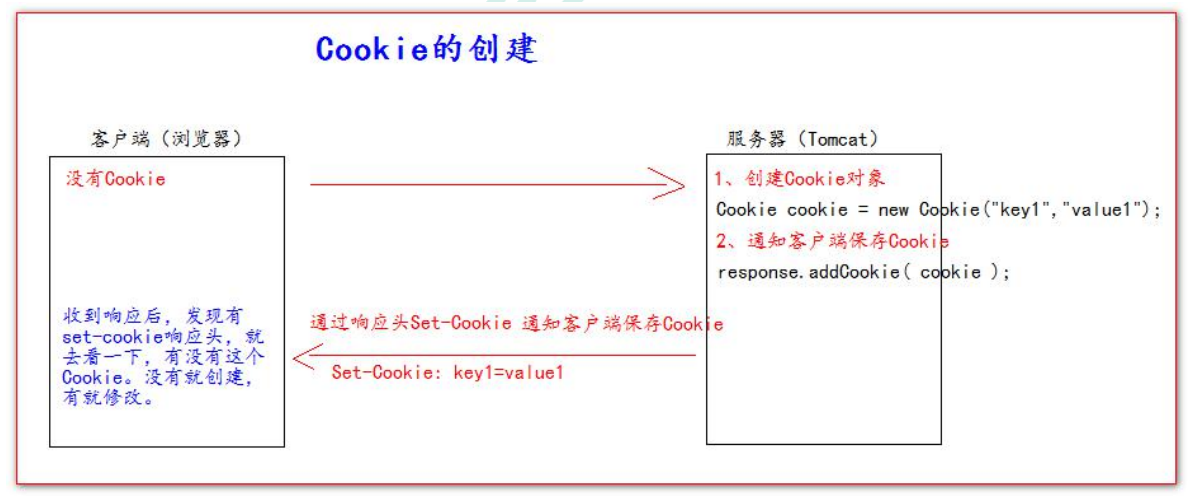
1
2
3
4
5
6
7
8
9
| protected void createCookie(HttpServletRequest req, HttpServletResponse resp) throws ServletException, IOException {
Cookie cookie = new Cookie("key2", "value2");
resp.addCookie(cookie);
resp.getWriter().write("cookie创建成功!");
}
|
3、服务器获取Cookie
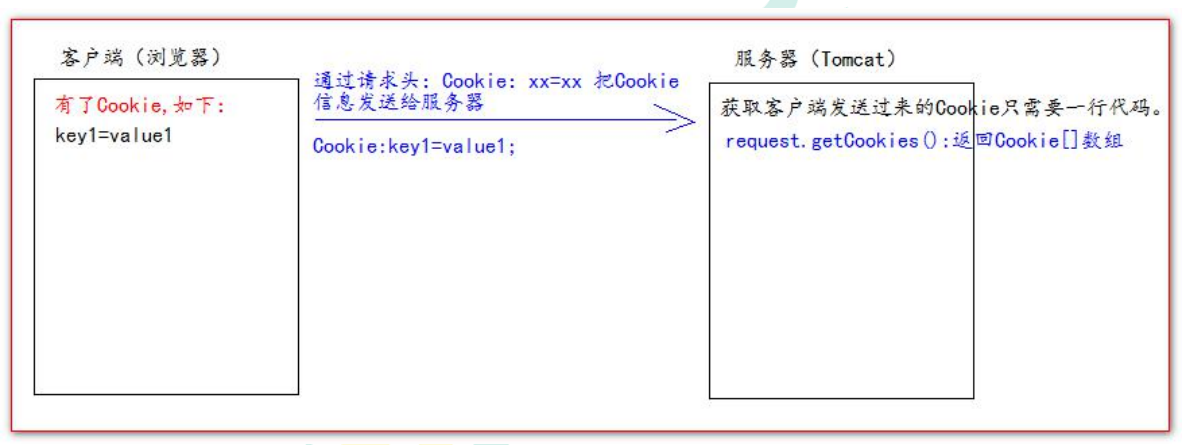
Cookie获取代码:
1
2
3
4
5
6
7
8
9
10
11
12
13
| protected void getCookie(HttpServletRequest req, HttpServletResponse resp) throws ServletException, IOException {
Cookie[] cookies = req.getCookies();
for (Cookie cookie : cookies) {
resp.getWriter().write(cookie.getName() + ": " + cookie.getValue() + "<br>");
}
Cookie findCookie = CookieUtils.FindCookie("key1", cookies);
if(findCookie != null){
resp.getWriter().write(findCookie.getName() + ": " + findCookie.getValue());
}
}
|
由于查找特定Cookie需要循环,所以将其封装到WebUtils工具类:
1
2
3
4
5
6
7
8
9
10
11
12
13
14
15
16
17
18
19
20
21
22
| public class CookieUtils {
public static Cookie FindCookie(String name, Cookie[] cookies){
if(name == null || cookies == null || cookies.length == 0){
return null;
}
for (Cookie cookie : cookies) {
if(name.equals(cookie.getName())){
return cookie;
}
}
return null;
}
}
|
4、Cookie值的修改
- 方案一:创建同名Cookie对象进行覆盖
- 方案二:找到要修改Cookie对象,使用Set方法设置
注意:
- 汉字,二进制:使用BASE64编码。
- 对于Version 0 cookie,值不应包含空格、方括号、圆括号、等号、逗号、双引号、斜杠、问号、at符号、冒号和分号。空值在所有浏览器上的行为不一定相同。
- Tomcat 8之后Cookie可以存中文,但特殊中文字符仍不支持,建议使用URL编码格式
1
2
3
4
5
6
7
8
9
10
11
12
13
14
15
16
17
18
19
20
21
22
| protected void updateCookie(HttpServletRequest req, HttpServletResponse resp) throws ServletException, IOException {
Cookie cookie = new Cookie("key1", "newValue");
resp.addCookie(cookie);
resp.getWriter().write(cookie.getName() + ": " + cookie.getValue());
Cookie cookie1 = CookieUtils.FindCookie("key2", req.getCookies());
if(cookie1 != null){
cookie1.setValue("newValue2");
resp.addCookie(cookie1);
}
resp.getWriter().write(cookie1.getName() + ": " + cookie1.getValue());
}
|
5、浏览器查看Cookie
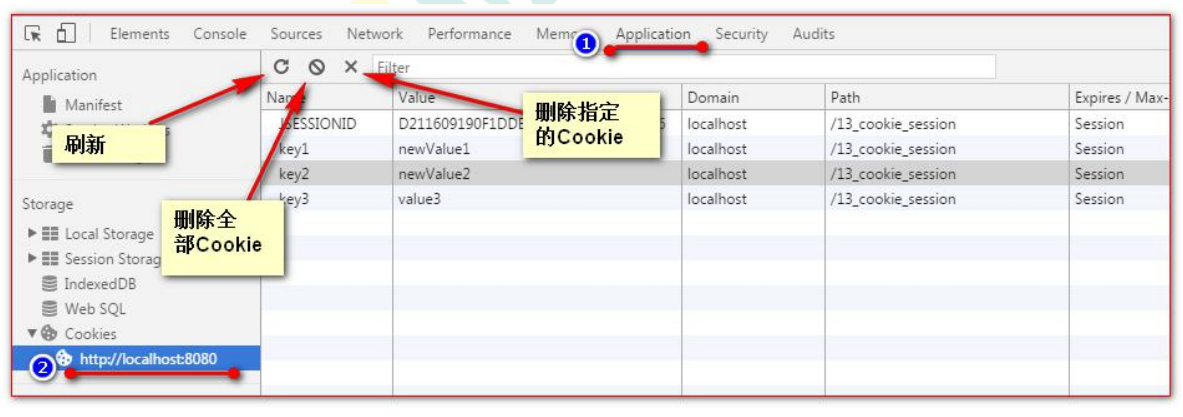
6、Cookie生命控制
Cookie 的生命控制指的是如何管理 Cookie 什么时候被销毁(删除)!
需要使用到 setMaxAge()方法:
- 正数,表示在指定的秒数后过期
- 负数,表示浏览器一关,Cookie 就会被删除(默认值是-1)
- 零,表示马上删除 Cookie
1
2
3
4
5
6
7
8
9
10
11
12
13
14
15
16
17
18
19
20
21
22
23
24
25
|
protected void defaultLife(HttpServletRequest req, HttpServletResponse resp) throws ServletException, IOException {
Cookie cookie = new Cookie("default", "default");
cookie.setMaxAge(-1);
resp.addCookie(cookie);
}
protected void deleteNow(HttpServletRequest req, HttpServletResponse resp) throws ServletException, IOException {
Cookie cookie = CookieUtils.FindCookie("key2", req.getCookies());
if(cookie != null){
cookie.setMaxAge(0);
resp.addCookie(cookie);
}
}
protected void life3600(HttpServletRequest req, HttpServletResponse resp) throws ServletException, IOException {
Cookie cookie = new Cookie("life3600", "life3600");
cookie.setMaxAge(3600);
resp.addCookie(cookie);
}
|
7、Cookie有效路径Path的设置
Cookie 的 path 属性可以有效的过滤哪些 Cookie 可以发送给服务器。哪些不发。
path 属性是通过请求的地址来进行有效的过滤。
注意:
- 访问:
http://localhost:8080/14_cookie_session/cookie.html不会得到path1的cookie,毕竟不匹配abc路径
- 访问:
http://localhost:8080/14_cookie_session/abc/cookie.html可以得到
- 请求头可以看到
set-cookie属性,但是application看不到!
- 默认情况:参数是web工程路径
/14_cookie_session,只有本工程可访问
- 要使本ip和port内所有项目共享:可以设置参数为
/ 即 http://ip:port/
- 不同的服务器间cookie的共享:使用Cookie对象的
setDomain(String path)方法,参数设置为一级域名,则一级域名相同的不同服务器之间Cookie可共享
1
2
3
4
5
6
| protected void setPath(HttpServletRequest req, HttpServletResponse resp) throws ServletException, IOException {
Cookie cookie = new Cookie("path1", "path1");
cookie.setPath(req.getContextPath() + "/abc");
resp.addCookie(cookie);
}
|
8、免用户名登录练习
即再次登录时,无需输入用户名,浏览器默认显示上次登录用户名!
如下图所示:
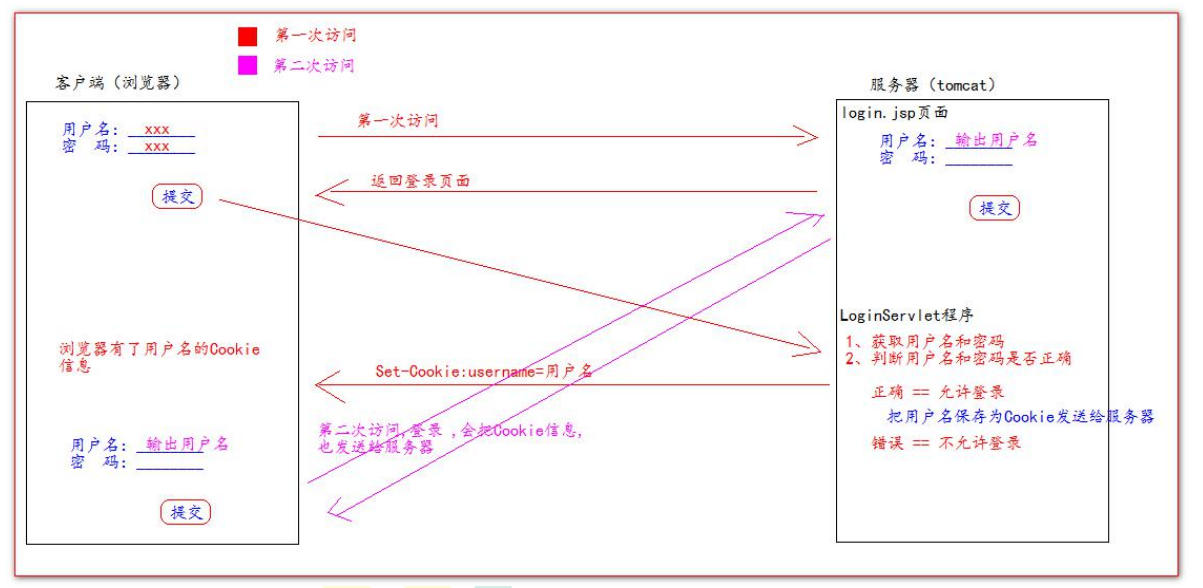
login.jsp:
1
2
3
4
5
| <form action="http://localhost:8080/14_cookie_session/loginServlet" method="get">
用户名:<input type="text" name="username" value="${cookie.username.value}">
密码:<input type="password" name="password">
<input type="submit" value="登录">
</form>
|
LoginServlet.java:
1
2
3
4
5
6
7
8
9
10
11
12
13
14
15
16
17
| public class LoginServlet extends HttpServlet {
@Override
protected void doGet(HttpServletRequest req, HttpServletResponse resp) throws ServletException, IOException {
String username = req.getParameter("username");
String password = req.getParameter("password");
if("itnxd".equals(username) == "123456".equals(password)){
Cookie cookie = new Cookie("username", username);
cookie.setMaxAge(60 * 60 * 24 * 7);
resp.addCookie(cookie);
System.out.println("登录成功!");
}else{
System.out.println("登录失败!");
}
}
}
|
二、Session
1、Session概述
Session是服务器端会话技术,在一次会话的多次请求间共享数据,将数据保存到服务器端!
- Session 就一个接口(HttpSession)。
- Session 就是会话。它是用来维护一个客户端和服务器之间关联的一种技术。
- 每个客户端都有自己的一个 Session 会话。
- Session 会话中,我们经常用来保存用户登录之后的信息。
2、Session的创建和获取
request.getSession():
- 第一次调用是:创建 Session 会话
- 之后调用都是:获取前面创建好的 Session 会话对象。
isNew():判断到底是不是刚创建出来的(新的)
**getId():**得到 Session 的会话 id 值。每个会话都有一个身份证号。也就是 ID 值。而且这个 ID 是唯一的!
1
2
3
4
5
6
7
8
9
10
11
| protected void createOrGetSession(HttpServletRequest req, HttpServletResponse resp) throws ServletException, IOException {
HttpSession session = req.getSession();
boolean isNew = session.isNew();
String id = session.getId();
resp.getWriter().write("Session的id是:" + id + "<br/>");
resp.getWriter().write("Session是否是新创建的:" + isNew + "<br/>");
}
|
3、Session域数据的存取
1
2
3
4
5
6
7
8
9
| protected void setAttribute(HttpServletRequest req, HttpServletResponse resp) throws ServletException, IOException {
req.getSession().setAttribute("session1", "session1");
resp.getWriter().write("在Session域中保存了数据!");
}
protected void getAttribute(HttpServletRequest req, HttpServletResponse resp) throws ServletException, IOException {
Object attribute = req.getSession().getAttribute("session1");
resp.getWriter().write("Session域中保存的session1的值是:" + attribute);
}
|
4、Session生命周期控制
Session超时指的是两次请求之间最大间隔时长!
**public void setMaxInactiveInterval(int interval):**设置 Session 的超时时间(以秒为单位),超过指定的时长,Session就会被销毁。
- 值为正数的时候,设定 Session 的超时时长。
- 负数表示永不超时(极少使用)
public int getMaxInactiveInterval():获取 Session 的超时时间
public void invalidate():让当前 Session 会话马上超时无效。
注意:
- Session 默认的超时时间长为 30 分钟。
- Tomcat配置文件的web.xml文件中配置了超时时长
1
2
3
4
5
6
7
|
<session-config>
<session-timeout>30</session-timeout>
</session-config>
|
1
2
3
4
|
<session-config>
<session-timeout>20</session-timeout>
</session-config>
|
- 也可通过
setMaxInactiveInterval(int interval)设置指定的Session超时
Session超时演示:
1
2
3
4
5
6
7
8
9
10
11
12
13
14
15
16
17
18
19
| protected void defaultLife(HttpServletRequest req, HttpServletResponse resp) throws ServletException, IOException {
int maxInactiveInterval = req.getSession().getMaxInactiveInterval();
resp.getWriter().write("Session的默认超时时长为:" + maxInactiveInterval + "秒")
}
protected void life3s(HttpServletRequest req, HttpServletResponse resp) throws ServletException, IOException {
req.getSession().setMaxInactiveInterval(3);
resp.getWriter().write("当前Session已设置为3秒后超时!");
}
protected void deleteNow(HttpServletRequest req, HttpServletResponse resp) throws ServletException, IOException {
req.getSession().invalidate();
resp.getWriter().write("当前Session点击该按钮后马上失效!");
}
|
5、浏览器和Session之间的技术
Session 技术,底层其实是基于 Cookie 技术来实现的。
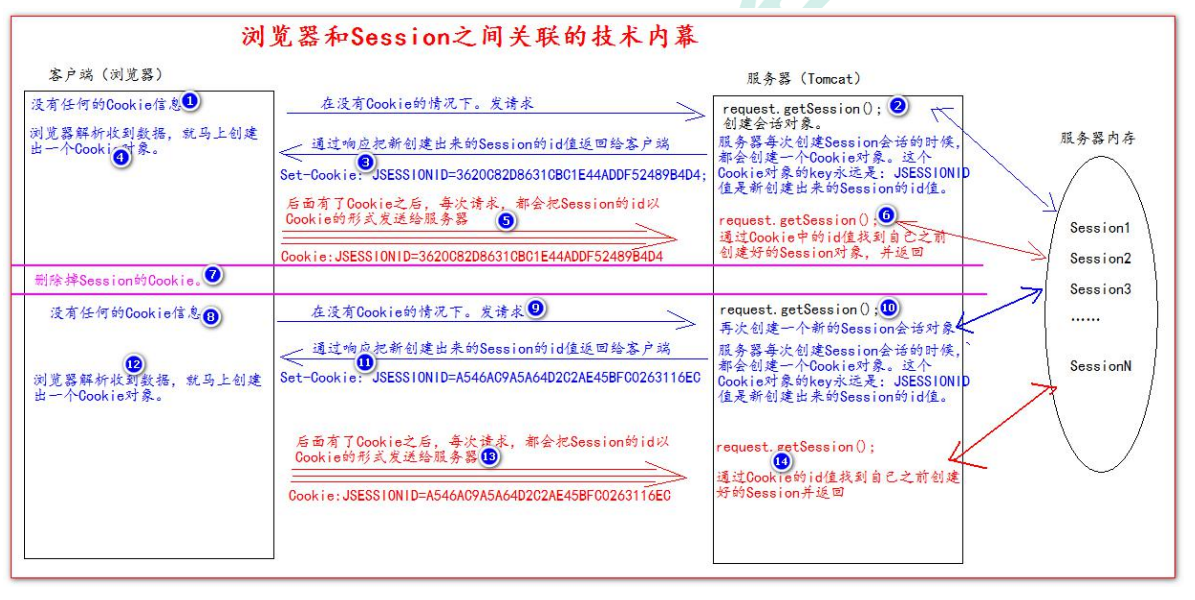
6、Session与Cookie总结
Session的特点:
- Session用于存储一次会话的多次请求数据,存在服务器端,一次会话只有一个session对象
- Session可以存储任意类型,任意大小的数据
Session与Cookie的区别:
- Session存储数据在服务器端,Cookie在客户端
- Session没有数据大小的限制,Cookie有(4KB)
- Session数据安全,Cookie相对不安全
客户端关闭服务器不关闭,两次获取的Session是否是同一个对象?
- 默认情况下,不是一个对象,默认情况下客户端关闭后Cookie就会被销毁,再次启动客户端发请求给服务器端,服务器端会重新创建Session并响应给客户端保存为Cookie
- 可通过设置该Session对应的Cookie(即
JSESSIONID)的存活时间实现同一个Session对象的目的!
客户端不关闭服务器关闭,两次获取的Session是否是同一个对象?
不是同一个对象,(第二次为新创建的,但数据相同!)但为了保证数据不丢失,Tomcat服务器完成两步操作:
- Session钝化:在服务器正常关闭之前,将Session对象序列化到硬盘上
- Session活化:在服务器启动之后,将Session文件反序列化成为内存中的Session对象







